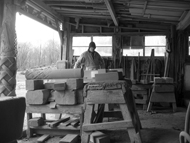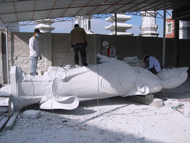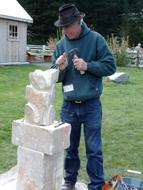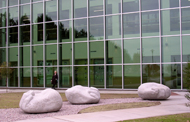- Details
-
Created: Sunday, 02 March 2008 04:56
If you have never been to the sandstone quarry in Tenino, Washington, think about swinging by this spring. Tenino is on old Hwy 99. Take exit 88 from I-5, about 20 miles south of Olympia. It’s a small pocket quarry, operated by Marenakos Rock Center that produces tough, tight, dark gray sandstone that is good for building and carving.
The resident sculptor, Keith Philips, knows all the history of the quarry and has dozens of stories that will have you marveling and laughing at the same time. Better call ahead to make sure the docent is in. 360-264-6213.
- Details
-
Created: Sunday, 02 March 2008 04:48
Ed. note: Most of the time we don’t get any letters to the Editors. But every now and then, we do. And when we do, they are usually thoughtful and thought provoking. Like this letter from Frank Quinn in Bandon, Oregon.
Hats off to Sculpture NorthWest for the Januarty/February issue which I found most thought provoking. Of particular interest were the three related articles on Jim Tobin, the “Stone Sculptors Travel to China,” and George Pratt’s “China Odyssey.” Their common theme has to do with the amazingly inexpensive yet high quality stone carving work that can be done in China by Chinese craftsmen from models provided by American or other Western artists.
Judging from the photos of Jim Tobin’s pieces (George Pratt’s 12 foot long Salmon can’t be seen in fine enough detail to say), the quality of that carving appears to be remarkably fine. But it also raises questions about what sculptors do as “artists” and what NWSSA as an organization promotes in the way of the “art” of stone carving.

For me, that “art” seems to be primarily a matter of applying acquired knowledge and the skills developed in practice in working with different tools and different types of stone in order to master a language for making objects that embody personal visions – ones that can sometimes be very intense or even profound – that can hopefully be shared and enjoyed by others. Such a view seems to underlie much of what NWSSA offers its members at its symposia with workshops on the use of hand or power tools, on different carving techniques, and in having guest artists and mentors on hand to help with problem solving in working with the medium.
I further tend to believe that those personal visions that are realized in the finished stone (whether good or not so good) only come fully into being in the carving process itself as the product of the artist and his tools in dialog with particular pieces of stone. Experienced sculptors, secure in the knowledge of what they can do, may very well picture in their minds, on paper, or with some 3-D model just what they want to do beforehand, and then proceed rapidly to excavate a close resemblance of that pre-existing mental image from a given piece of stone. Yet the finished piece and the artist’s thinking about it in the course of working on it are still bound to be influenced by the limitations of the tools used and the faults, textures and resistance of the stone itself. The end product is never exactly the same as that pre-existing idea, however vague or precise it may have been. Many artists and writers on the subject in the last century seem to share a view that the “art” of stone sculpture resides not so much in that prior image as in the finished piece which manifests the artist’s mastery in embodying his or her personal vision as it evolved in the carving.
These ideas about the art of stone sculpture seem seriously challenged by your articles on the new carving factories in China that have mastered the ability to turn out carved pieces for Western artists much more quickly and cheaply than the artists themselves. But, who, then, are the “artists” – those who create the mental images and models to be executed, or those who engage in physical dialog with the stone to produce the finished work? Both Jim Tobin and George Pratt seem quite sensitive to this question. When asked what made him want to be an artist, Jim expressed unease about the term “artist,” saying, “I’m more comfortable thinking of myself as a designer of ideas.” George Pratt mentions his “mental wrestling match with the philosophy of selling to my client a signed artwork that was in fact carved by others,” when circumstances forced him to play the China card in order to stay within the budget constraints of his commission. Helping to ease his conscience, he found he would still need to do a week’s work finishing off details that were not wholly to his liking. Nevertheless, he concludes that the time, money, and effort saved by sending models to China to have large scale granite pieces carved there definitely beats doing it locally.
This brings to mind earlier practices in the West when big name artists managed large studios that employed others to do the grunt work of wood or stone carving, bronze casting, or even spreading paint around on large canvases. The artist was conceived to be a genius whose designs would be executed by craftsmen, leaving the master artist to come by at the end for a few finishing touches to authenticate the piece as a genuine work of his hand.
Is globalization now pushing artists again in that direction? When American industry finds it more profitable to outsource production work to Third World countries where there are no unions and few inconvenient labor laws, the practice is often justified on the grounds that American genius will still be managing and designing the product as well as setting the standards for modern day coolies to do the work. Karl Hufbauer, one of the five NWSSA sculptors to travel to China to explore some of the large scale sculpting enterprises newly sprung up there, writes of the “astonishment” he and the others felt at the sophistication of the work being done by the Chinese workers. Yet, “how will American sculptors compete in the decades ahead?” he wonders.
His own first answer seems to echo that of the multinationals: “First and most important, we must strive to develop designs that, in fresh ways, stretch the envelope.” But how long can we expect to have a monopoly on creative genius in designing if we cede to others the actual give and take of working out our ideas in stone? Again, where is the art of stone carving to be found?





